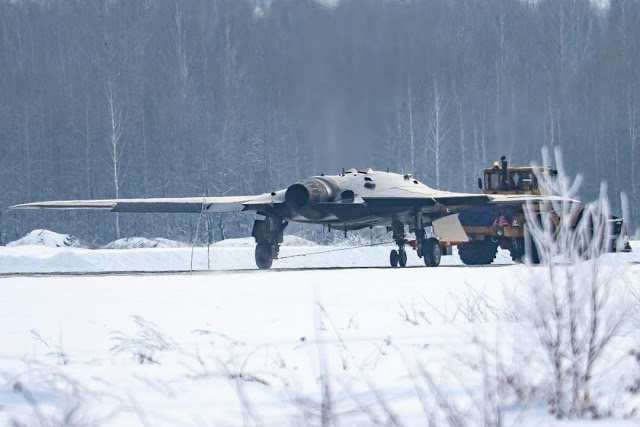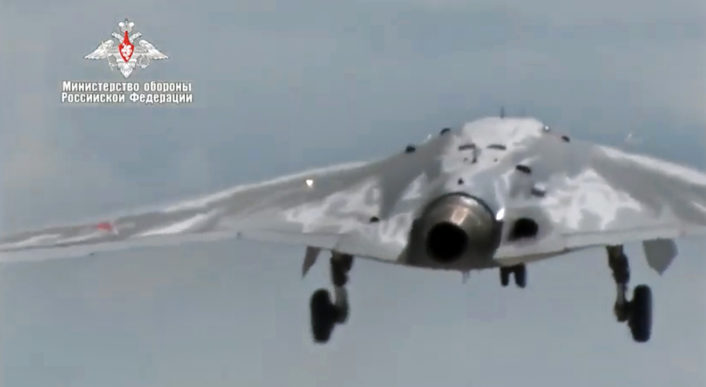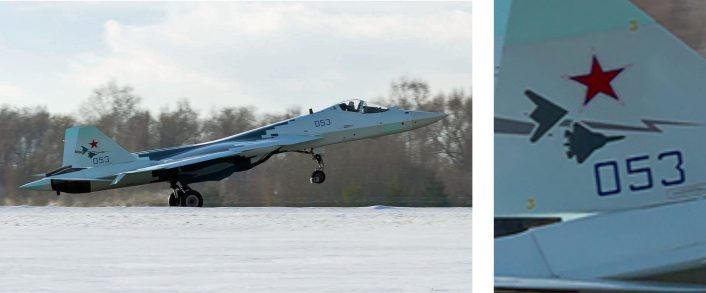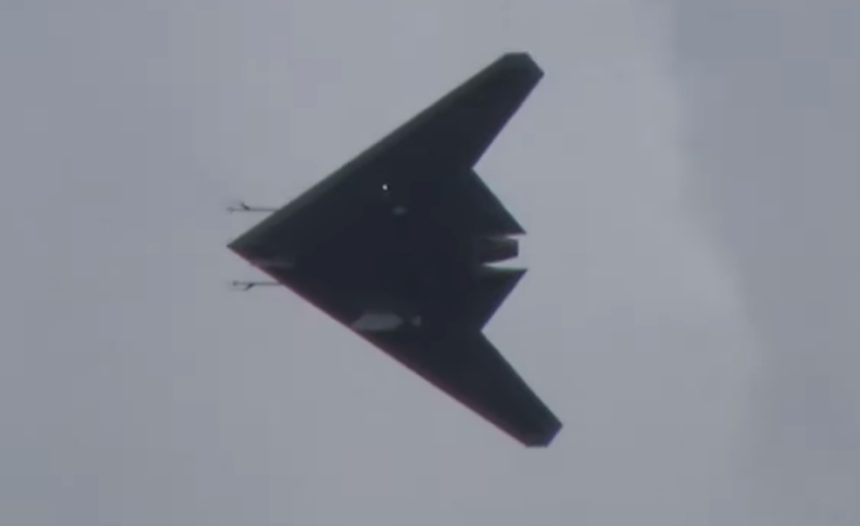New “Hunter-B” Drone to Provide Armed, Remotely-Piloted Capability.
According to Russian news agencies, Russia’s new Sukhoi S-70 Okhotnik or “Hunter-B” drone made its first flight on Saturday, Aug. 3, 2019. The story was officially released following the successful test flight by the Russian Defense Ministry via the government news agency TASS. No video was released of the successful test flight until this morning. The aircraft project has also been referred to as the “Udarno-Razvedyvatelnyi Bespilotnyi Kompleks” or “Strike-Reconnaissance Unmanned Complex” according to some reports such as a Jan. 25, 2019 report by Popular Mechanics defense analyst Kyle Mizokami.
The first flight shown in the video was a daytime sortie held in overcast conditions. The video shows the aircraft on take-off roll, rotating for take-off followed by a climb-out, and then some air-to-air video of the Su-70 Hunter-B drone executing some basic turns until it lands. This is a fairly standard profile for an aircraft’s first flight.
The new Sukhoi S-70 “Hunter-B” first flight is significant since the aircraft is to provide the first heavy, jet-powered, armed, long-range drone capability for Russia. The remotely piloted aircraft, or “RPA” is based on a 2005 RPA design prototype by Mikoyan-Gurevich (MiG) called the “Skat” that was first seen as a mock-up at the MAKS 2007 Aviasalon air show outside Moscow.
The new Su-70 Hunter-B is said to have low-observable capabilities, providing it with the ability to penetrate heavily defended airspaces without detection to conduct covert precision strikes. The remotely piloted aircraft may also be tasked to work as a “leading edge of battle” penetrator, conducting the first strikes such as enemy air defense suppression during the opening phase of a major air war.

The Su-70 Hunter-B is a large RPA weighing nearly “20 tons” according to reports, of almost twice the weight of a U.S.-built F-16 Fighting Falcon. A noteworthy feature of the new Su-70 is its conventionally configured, round exhaust system. U.S. UCAV/RPA designs such as the Northop Grumman X-47B, feature a flat, louvered exhaust configuration to reduce both radar cross section (RCS) to enhance low-observability and to moderate the aircraft’s infra-red (IR) heat signature. This round exhaust is seemingly contradictory to the design cues on the forward intake of the Su-70, a trapezoidal engine inlet that appears to be configured to hide the engine fan blades from radar reflection from the bottom/front of the aircraft to enhance stealth. Several sources also suggest the aircraft is made primarily of composite material, a likely additional low-observable feature.

(Russia MOD via YouTube)
The single powerplant of the Su-30 Hunter-B is said to be the Saturn AL-31 turbofan originally developed by Russian manufacturing and design firm Lyulka. This jet engine is proven on the Su-27 family of aircraft and China’s Chengdu J-10 derivative of the Su-27. Depending on the version, the Saturn AL-31 delivers approximately 30,000 lbs. of thrust, potentiallyu providing the Su-30 Hunter-B with a thrust-to-weight ratio of approximately 1:1.
Interestingly, last year an example of Russia’s new Sukhoi Su-57 was seen with the rough plan form shape of a Hunter-B drone stenciled on its upper surfaces and graphics on the tail that showed the plan-form view of a Hunter-B drone along with an Su-57 in plan view connected by a lightning bolt graphic. The insignia on the Su-57 suggest some operational link between the Su-57 and the Hunter-B, either in testing or in proposed operational use. The new Hunter-B may eventually provide some enhanced, long range sensor capability for surveillance and targeting by the Su-57 via a data link similar to the U.S. F-35 Joint Strike Fighter’s sensor networking capability.

(Photo: via RussianPlanes.net/Alexei Karpulev)
Before the Hunter-B’s first flight on Saturday, reports surfaced about the possible armament on the aircraft. “The Okhotnik’s arsenal includes air-to-surface missiles and an array of bombs (glide and operator-controlled) that will not be suspended from the wings, but hidden inside the body to reduce visibility on enemy radar,” Professor Vadim Kozyulin of the Russian Academy of Military Sciences told the publication “Russia Beyond”. These air-dropped weapons could include Russia’s OFZAB-500 fragmentation/incendiary bomb or the ODAB-500PMV barometric high-pressure fuel-air explosive munition. Both of these air delivered weapons were employed successfully by Russia during their campaign in Syria from other delivery platforms.









